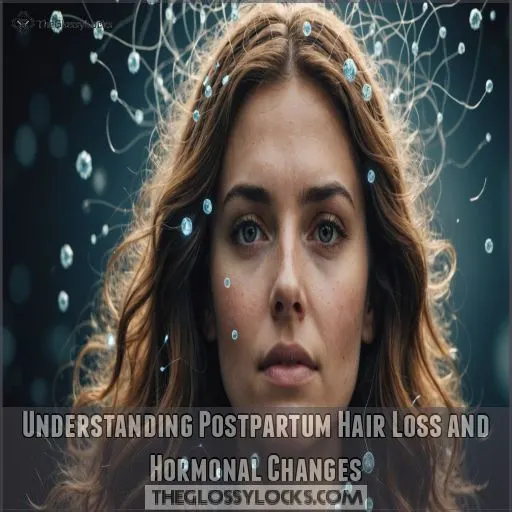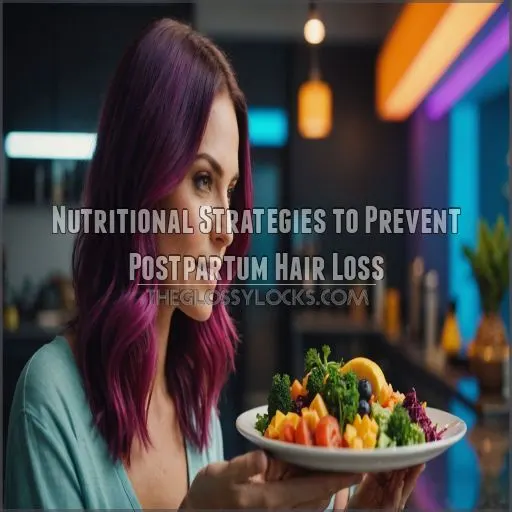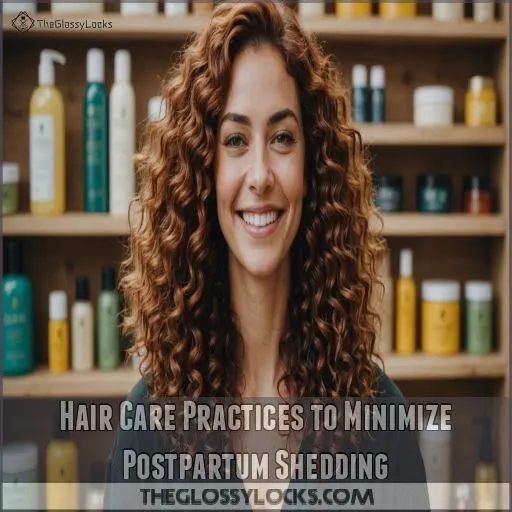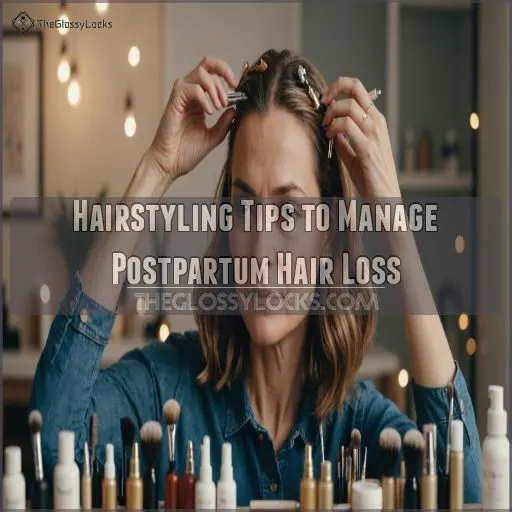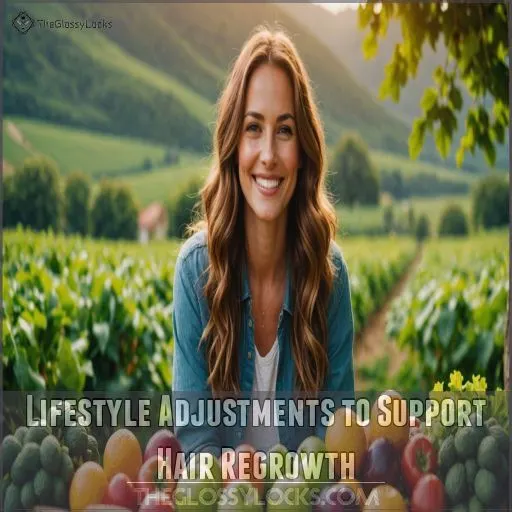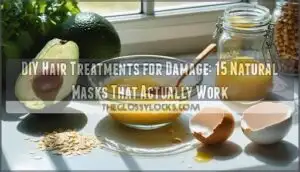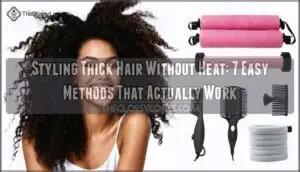This site is supported by our readers. We may earn a commission, at no cost to you, if you purchase through links.
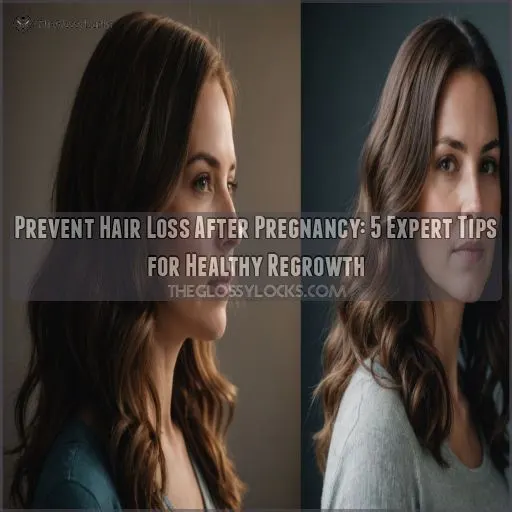 To prevent hair loss after pregnancy, you’re not alone in this hairy situation!
To prevent hair loss after pregnancy, you’re not alone in this hairy situation!
Start by treating your locks with kid gloves – gentle washing and combing are key. Ditch the heat and tight styles; your hair needs a vacation too.
Fuel up on nutrient-rich foods and stay hydrated – think of it as a spa day for your scalp. Consider a sassy new ‘do that adds volume without the fuss.
Remember, sleep isn’t just for the baby; it’s really important for your hair’s beauty rest. Stress less (easier said than done, right?) and embrace your body’s changes.
With these tips, you’ll be on your way to luscious locks in no time. But wait, there’s more to this postpartum hair journey…
Table Of Contents
- Key Takeaways
- Understanding Postpartum Hair Loss and Hormonal Changes
- Nutritional Strategies to Prevent Postpartum Hair Loss
- Hair Care Practices to Minimize Postpartum Shedding
- Hairstyling Tips to Manage Postpartum Hair Loss
- Lifestyle Adjustments to Support Hair Regrowth
- Frequently Asked Questions (FAQs)
- How can I prevent hair loss after pregnancy?
- How can I help female hair loss?
- How can I prevent postpartum hair loss?
- Can I lose hair if I’m Pregnant?
- Is Your Postpartum Hair Loss Normal?
- Can you prevent postpartum hair loss?
- How long does hair loss last after giving birth?
- Does every woman go through postpartum hair loss?
- Does biotin help postpartum hair loss?
- Does breastfeeding duration affect postpartum hair loss?
- Can preterm labor increase risk of hair loss?
- When does postpartum hair loss typically peak?
- What percentage of women experience postpartum hair loss?
- Is inflammation linked to postpartum hair loss?
- Conclusion
Key Takeaways
- Nourish your body from the inside out. You’re not just eating for two anymore, but your hair is still hungry! Keep up with those prenatal vitamins, load up on iron-rich foods, and stay hydrated. Think of it as a spa day for your scalp – but instead of cucumbers on your eyes, you’re munching on spinach salads.
- Treat your tresses like delicate silk. Ditch the tight ponytails and focus on 3C hair care for gentle hair practices
. Use a wide-toothed comb, opt for sulfate-free shampoos, and give your blow dryer a much-needed vacation. Your locks will thank you by sticking around longer!
- Rock styles that pump up the volume. Channel your inner hair model with layered cuts, textured bobs, or even temporary extensions. It’s like an optical illusion for your mane – creating the appearance of fuller, thicker hair while you wait for those baby hairs to grow back.
- Remember, this too shall pass. Postpartum hair loss peaks around 4-5 months after birth, but for most moms, it’s back to business as usual by their little one’s first birthday. In the meantime, cut yourself some slack – you’re growing a human and regrowing your hair. That’s multitasking at its finest!
Understanding Postpartum Hair Loss and Hormonal Changes
You’ve just had a baby, and now your hair’s falling out?
Don’t panic—it’s a totally normal part of the postpartum journey.
Let’s unpack what’s happening with your hair and hormones, so you can understand why your luscious pregnancy locks are taking a temporary vacation.
Pregnancy’s Impact on Hair Growth Cycles
During pregnancy, your hair’s growth cycle takes an unexpected twist. The hormone rollercoaster ride affects your locks in surprising ways:
- More hair stays in the growth phase
- Fewer strands take a shedding vacation
- Your mane might seem thicker and fuller
- Some women experience increased body hair
- Others may notice thinning in certain areas
This hair-raising journey is thanks to elevated estrogen levels, which extend the anagen (growth) phase of your hair follicles . Don’t worry, though – this temporary change is just your body’s way of prepping for motherhood!
Hormonal Fluctuations After Childbirth
Riding the hormonal rollercoaster after giving birth? You’re not alone! Your body’s experiencing a dramatic shift as estrogen levels plummet.
This hormone nosedive affects your hair’s growth cycle, pushing more follicles into the resting phase, particularly after changes in hormonal birth control
. While it might feel alarming, remember it’s your body’s natural response to postpartum changes.
Breastfeeding can also influence hormone levels, potentially prolonging the hair loss phase .
Don’t worry though – your luscious locks will make a comeback!
Normal Timeline for Postpartum Hair Shedding
Three key phases mark your postpartum hair shedding journey. You’ll likely notice increased hair loss around 3-5 months after giving birth, with peak shedding at 4-5 months . Don’t panic! This is your body’s natural reset button.
- Initial stability (0-3 months)
- Noticeable shedding (3-5 months)
- Gradual tapering (6-12 months)
- Return to normal (12+ months)
Remember, your luscious locks will make a comeback. It’s just taking a well-deserved postpartum vacation!
Differentiating Between Normal and Excessive Hair Loss
Distinguishing between normal and excessive postpartum hair loss can feel like walking a tightrope. While shedding up to 100 hairs daily is typical, postpartum hair loss often exceeds this.
| Hair Loss Indicator | Normal | Concerning |
|---|---|---|
| Duration | up to 6 months | over 6 months |
| Shedding Pattern | Gradual | Sudden, patchy |
| Scalp Health | No visible changes | Redness, inflammation |
Remember, your hair’s fullness should return by your baby’s first birthday. If you’re worried, consult your doctor.
Nutritional Strategies to Prevent Postpartum Hair Loss
While you can’t completely prevent postpartum hair loss, you can support your body’s hair regrowth process through smart nutrition, especially since stress-induced hair loss is a common concern
.
Let’s explore some key dietary strategies that’ll help you nourish your locks from the inside out, giving your hair the boost it needs during this time.
Essential Nutrients for Hair Health
To nourish your locks from the inside out, focus on these hair-boosting nutrients. Iron keeps your follicles happy, while biotin and protein are the building blocks for healthy strands.
Don’t forget zinc and vitamin D, which play key roles in hair growth.
While herbal supplements might seem tempting, stick to food sources first. Remember, what’s good for your body is good for your hair – so fuel up wisely!
Importance of Continued Prenatal Vitamin Intake
The secret to maintaining your luscious locks after pregnancy might be hiding in your medicine cabinet. Continuing your prenatal vitamins postpartum isn’t just good for your overall health—it’s a game-changer for your hair.
- Replenishes nutrients depleted during pregnancy and breastfeeding
- Supports new hair growth after postpartum shedding
- Maintains hair texture and healthy appearance through proper sulfate free shampoo
- Provides essential vitamins often deficient in breastfeeding moms
Keep at it until you’ve finished breastfeeding, mama. Your hair will thank you!
Balanced Diet for Postpartum Hair Growth
How can you nourish your hair from the inside out? A balanced diet rich in key nutrients is really important for postpartum hair growth.
Focus on incorporating these hair-boosting foods into your meals:
| Nutrient | Function | Food Sources |
|---|---|---|
| Iron | Carries oxygen to follicles | Red meat, spinach, leafy greens like kale and broccoli |
| Protein | Builds hair structure | Eggs, fish, beans |
| Biotin | Braiding can help prevent hair breakage and promote hair growth | Nuts, sweet potatoes, avocados |
| Vitamin C | Aids collagen production | Berries, citrus fruits, peppers |
Remember, nourishing your body helps nourish your locks!
Hydration and Its Role in Hair Health
While you’re nourishing your body with a balanced diet, don’t forget about hydration’s starring role in hair health.
Proper water intake is key for supporting hair growth and maintaining quality.
Think of your hair as a thirsty plant – without enough water, it’ll wilt and lose its luster. Aim to sip water throughout the day, keeping your body (and hair follicles) happily hydrated .
Hair Care Practices to Minimize Postpartum Shedding
You’ve got enough on your plate as a new mom without worrying about your hair falling out in clumps.
Let’s explore some simple hair care practices that can help minimize postpartum shedding and keep your locks looking luscious while you navigate this wild ride of motherhood.
Gentle Hair Washing and Drying Techniques
After addressing your nutritional needs, it’s time to focus on gentle hair care. Your postpartum locks need extra TLC to minimize shedding.
- Cold water rinses: They’re like a revitalizing spa day for your scalp.
- Scalp massages: Think of them as a mini vacation for your follicles.
- Air drying: Let your hair take a breather from heat styling.
Remember, treat your hair like a delicate silk scarf, not a sturdy rope!
Choosing Appropriate Hair Care Products
Now that you’ve mastered gentle washing, let’s talk products. Your postpartum hair needs extra TLC, so choose wisely!
| Product Type | Look For | Avoid |
|---|---|---|
| Shampoo | Sulfate-free, biotin | Harsh sulfates |
| Conditioner | Lightweight, volumizing | Heavy silicones |
| Serum | Coconut oil, anti-breakage | Alcohol-based |
| Mask | Protein-rich, moisturizing | Synthetic fragrances |
| Supplements | Viviscal (if not breastfeeding) | Unnecessary additives |
Remember, what works for your bestie mightn’t work for you. Listen to your locks!
Avoiding Harsh Chemical Treatments and Heat Styling
Resist the temptation to reach for harsh chemicals or your trusty hot tools during postpartum hair recovery. Your locks are already fragile, so give them a break from heat styling and chemical treatments.
Embrace heatless styling techniques and explore natural hair products to nurture your tresses back to health.
Remember, your scalp health is important too – try a nourishing hair mask to pamper both your strands and scalp.
Proper Hair Brushing and Detangling Methods
While dealing with postpartum hair loss, gentle brushing is your secret weapon.
Start with a wide-toothed comb to tackle those stubborn knots, working from the ends up to prevent breakage.
For a touch of self-care, treat yourself to a soothing scalp massage – it’s like a spa day for your hair!
Remember, different brush types suit different textures, so find your perfect match to keep those locks luscious.
Hairstyling Tips to Manage Postpartum Hair Loss
You’re not alone if you’re feeling frustrated with postpartum hair loss.
Let’s explore some smart hairstyling tricks that can help you manage thinning locks and boost your confidence during this temporary phase.
Haircuts and Styles That Create Volume
With the right haircut and style, you can create the illusion of fuller, thicker hair during your postpartum journey.
Opt for layered cuts that add movement and volume, or try a textured bob for a chic, low-maintenance look.
Side-swept bangs can cleverly conceal thinning around your hairline – a trick many celebrity moms use.
For special occasions, consider voluminous blowouts or temporary hair extensions to boost your confidence and give your locks a glamorous makeover.
Avoiding Tight Hairstyles and Hair Accessories
After finding the perfect cut, it’s time to rethink your styling habits.
Tight hairstyles can be your hair’s worst enemy during postpartum shedding . Ditch those hair elastics and opt for gentler alternatives.
Loose ponytails, soft braids, and scrunchies are your new best friends. They’ll give your locks some breathing room and prevent unnecessary tugging.
Remember, your hair needs TLC now more than ever – treat it like the delicate treasure it is, and give it the TLC it deserves. Your hair needs gentler alternatives now more than ever.
Using Hair Volumizing Products Effectively
Now that you’ve ditched those tight styles, let’s pump up the volume! Volumizing products can be your secret weapon against postpartum hair loss.
Look for shampoos and conditioners with bamboo extract – they’re like a protein shake for your locks.
When applying, focus on your roots and crown area. Gently massage the product in to stimulate blood flow. Remember, a little goes a long way – you don’t want to weigh down those precious strands, with a little going a long way!
Temporary Solutions Like Hair Fibers and Extensions
Hair fibers and extensions can be your secret weapons in the battle against postpartum hair loss.
These temporary fixes offer a quick confidence boost when you’re feeling less than fabulous.
From clip-ins to halos, there’s an option for every budget and skill level.
Just remember, while these solutions can work wonders, they’re not one-size-fits-all. Experiment to find what works best for your hair type and lifestyle.
Lifestyle Adjustments to Support Hair Regrowth
You’ve got a lot on your plate as a new mom, but don’t forget to take care of yourself too.
Making a few simple lifestyle tweaks can work wonders for your hair’s health and regrowth, helping you feel more like your pre-pregnancy self.
Stress Management Techniques for New Mothers
Stress can sneak up on you like a ninja in the night, wreaking havoc on your hair health.
To keep those stress hormones at bay, embrace mindfulness techniques such as meditation or deep breathing exercises.
Yoga isn’t just for zen masters; it’s a fantastic way to unwind and boost your hair game .
Remember, asking for help isn’t a sign of weakness—it is a superpower. Lean on your support network and don’t be afraid to delegate tasks.
Your hair (and sanity) will thank you!
Importance of Adequate Sleep for Hair Health
You’ve probably heard the phrase "beauty sleep," but it’s more than just a saying. Adequate sleep is really important for hair health, especially after pregnancy. Sleep deprivation can disrupt your hair growth cycle and increase stress, leading to more hair loss.
To support healthy hair regrowth:
- Aim for 7-9 hours of sleep nightly
- Create a relaxing bedtime routine
- Invest in a comfortable pillow and mattress
Remember, when you’re sleeping, your body’s working overtime to restore and rejuvenate – including those precious locks!
Frequently Asked Questions (FAQs)
How can I prevent hair loss after pregnancy?
Embrace your mane’s journey, mama!
Nourish with prenatal vitamins, rock gentler hairstyles, and say goodbye to tight ponytails.
While you can’t prevent postpartum shedding entirely, these steps’ll help you navigate this temporary phase with grace.
How can I help female hair loss?
Tackle female hair loss head-on with minoxidil, the FDA-approved treatment.
You can also explore laser therapy or PRP injections.
Don’t forget to nourish your locks with a balanced diet and scalp massages.
How can I prevent postpartum hair loss?
While you can’t completely prevent postpartum hair loss, there are ways to manage it.
Take prenatal vitamins, avoid tight hairstyles, and use gentle hair care products.
Remember, it’s temporary and usually peaks around four months postpartum, or specifically around four months postpartum (Source).
Can I lose hair if I’m Pregnant?
Yes, you can lose hair during pregnancy.
It’s not uncommon and affects 40-50% of women.
Hormonal changes, stress, or nutrient deficiencies can trigger this.
Don’t worry though – it’s usually temporary and resolves after delivery.
Is Your Postpartum Hair Loss Normal?
Don’t pull your hair out! Your postpartum hair loss is as normal as can be.
It’s a common occurrence affecting about half of new moms.
You’ll typically notice increased shedding 3-5 months after giving birth.
Can you prevent postpartum hair loss?
Unfortunately, you can’t fully prevent postpartum hair loss.
It’s a natural process triggered by hormonal changes after childbirth.
However, you can take steps to minimize its impact and support healthy hair regrowth.
How long does hair loss last after giving birth?
Postpartum hair loss typically starts 2-3 months after giving birth and peaks around 4-5 months.
You’ll likely see improvement within 6-12 months, with most women’s hair returning to normal by their baby’s first birthday (Source).
Does every woman go through postpartum hair loss?
Over 90% of women experience postpartum hair loss .
You’re not alone in this journey.
While it’s incredibly common, it’s not universal.
Some lucky moms dodge this hairy situation, but most face temporary thinning.
Does biotin help postpartum hair loss?
Biotin’s benefits for postpartum hair loss aren’t clear-cut.
While it’s important for hair health, research shows mixed results.
You’re better off focusing on a balanced diet rich in hair-friendly nutrients like vitamin E.
Does breastfeeding duration affect postpartum hair loss?
Research suggests longer breastfeeding may increase your chances of postpartum hair loss.
You’re not alone – over 90% of moms experience this!
Consider discussing your feeding plan with your doctor to find the right balance for you and your feeding plan .
Can preterm labor increase risk of hair loss?
Yes, preterm labor may increase your risk of postpartum hair loss.
A study found that women who experienced preterm labor had higher rates of hair shedding after giving birth.
It’s like your body’s throwing you a curveball!
When does postpartum hair loss typically peak?
You’re in for a hair-raising experience!
Postpartum hair loss typically peaks around four to five months after giving birth.
Don’t worry, though – it’s a completely normal part of your body’s postpartum journey. (Source)
What percentage of women experience postpartum hair loss?
According to a recent study, a whopping 8% of women experience postpartum hair loss.
That’s right, you’re in good company!
Most new moms find themselves shedding more than just baby weight after delivery.
Is inflammation linked to postpartum hair loss?
While inflammation’s role isn’t crystal clear, research suggests a potential link.
Preterm labor, often associated with inflammation, correlates with postpartum hair loss.
This connection hints at inflammation’s possible influence on your hair’s growth cycle after giving birth, especially related to potential hormonal pituitary gland dysfunction
.
Conclusion
Dealing with postpartum hair loss can feel like weathering a storm, but you’re equipped with the tools to sail through it.
By nourishing your body, treating your tresses gently, and embracing hair-friendly styles, you’ll be well on your way to preventing excessive hair loss after pregnancy.
Remember, this journey is as unique as your little one’s first smile. With patience and these expert tips, you’ll soon see your locks bouncing back to their former glory.
You’ve got this, mama – here’s to healthy hair and happy parenting!

